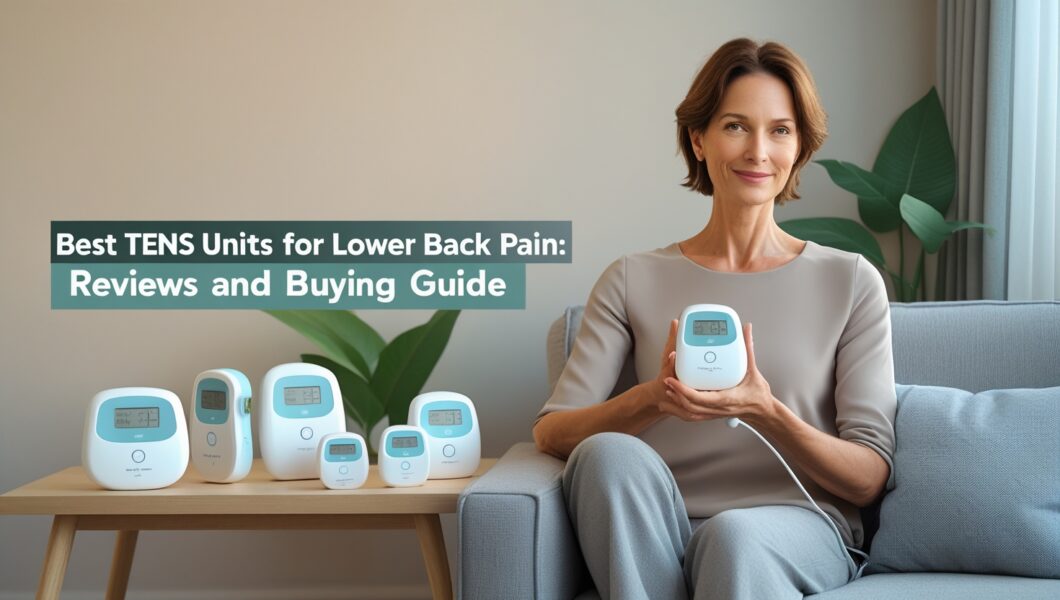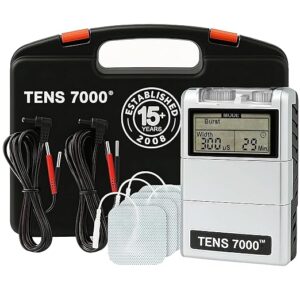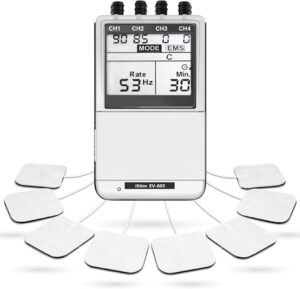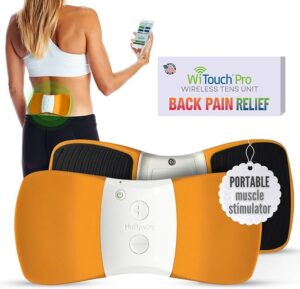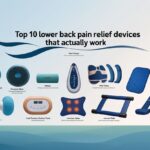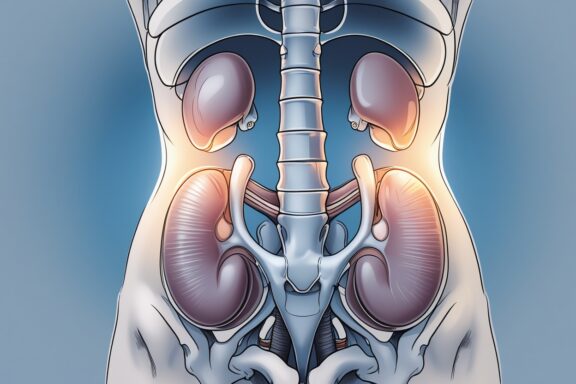Lower back pain affects millions of people worldwide, making simple daily activities feel like monumental challenges. Whether you're dealing with chronic discomfort or acute episodes, finding effective relief doesn't always require prescription medications or invasive procedures. TENS units have emerged as a popular, non-invasive solution that's helping countless individuals reclaim their comfort and mobility.
What Are TENS Units and How Do They Work?
TENS stands for Transcutaneous Electrical Nerve Stimulation – quite a mouthful, isn't it? But don't let the fancy name intimidate you. These compact devices are actually pretty straightforward in their approach to pain relief. They work by delivering low-voltage electrical impulses through electrode pads placed on your skin, essentially “jamming” pain signals before they reach your brain.
The science behind TENS therapy is rooted in the gate control theory of pain. Simply put, your nervous system can only process a limited amount of sensory information at once. When the TENS unit sends electrical pulses to your nerves, it effectively “closes the gate” on pain signals, providing relief without masking the underlying issue. Pretty clever, right?
Why TENS Units Are Perfect for Lower Back Pain
Lower back pain is notoriously stubborn. It creeps up on you at the worst possible moments – during important meetings, family gatherings, or when you're trying to enjoy a peaceful night's sleep. Traditional pain management often involves a cocktail of medications that can leave you feeling groggy or dealing with unwanted side effects.
TENS units offer a refreshing alternative. They're drug-free, portable, and can be used whenever you need relief. Unlike heating pads or ice packs, you can wear a TENS unit discreetly under your clothing while going about your daily routine. Talk about convenience! Many users report significant improvements in their pain levels within just 15-30 minutes of use.
Top 5 TENS Units for Lower Back Pain Relief
1. PowerDot Smart Muscle Stimulator
This isn't your grandfather's TENS unit. The PowerDot combines cutting-edge technology with user-friendly design, making it a standout choice for tech-savvy pain sufferers. Its smartphone app allows you to customize programs, track your progress, and even share data with healthcare providers.
Key Features:
- Bluetooth connectivity for smartphone control
- 20+ pre-programmed settings
- Rechargeable battery with 10+ hour life
- FDA-cleared for over-the-counter use
The PowerDot's strength lies in its versatility. Whether you're dealing with acute lower back spasms or chronic discomfort, this device adapts to your needs. Users frequently praise its intuitive interface and the ability to fine-tune settings for maximum effectiveness.
2. Omron Pocket Pain Pro TENS Unit
Sometimes, simplicity wins the day. The Omron Pocket Pain Pro proves that you don't need bells and whistles to get effective pain relief. This compact unit packs a punch in a package smaller than most smartphones.
Key Features:
- Ultra-portable design
- 15 intensity levels
- 5 pre-set pain management modes
- Long-lasting battery life
What sets this unit apart is its no-nonsense approach. You won't find complicated menus or confusing settings here. Just straightforward pain relief that works. Many users appreciate how easy it is to slip into a pocket or purse for on-the-go relief.
3. iReliev TENS + EMS Combination Unit
Why settle for just TENS when you can have both TENS and EMS (Electrical Muscle Stimulation) in one device? The iReliev combination unit offers comprehensive pain management and muscle rehabilitation in a single, affordable package.
Key Features:
- Dual TENS and EMS functionality
- 24 pre-programmed settings
- Large, easy-to-read LCD display
- Comfortable electrode pads included
This unit excels at addressing both pain relief and muscle strengthening. If your lower back pain stems from weak supporting muscles, the EMS function can help rebuild strength while the TENS provides immediate relief. It's like having a physical therapist in your pocket!
4. HealthmateForever Pro12AB TENS Unit
For those who want professional-grade features without the professional price tag, the HealthmateForever Pro12AB delivers exceptional value. This unit offers more programs than most users will ever need, ensuring you'll find the perfect setting for your specific type of lower back pain.
Key Features:
- 12 pre-programmed modes
- Dual independent channels
- Adjustable timer settings
- Comprehensive accessories package
The Pro12AB's strength is its flexibility. With independent dual channels, you can treat multiple areas simultaneously or focus intensive therapy on your most problematic spots. Users love the variety of electrode sizes included, allowing for precise targeting of pain areas.
5. TENS 7000 Digital TENS Unit
A proven performer that's been helping people manage pain for years, the TENS 7000 combines reliability with affordability. This unit has earned its reputation through consistent performance and thousands of satisfied users.
Key Features:
- Dual channel output
- Adjustable pulse amplitude, width, and rate
- Easy-to-use interface
- FDA-cleared for safety
The TENS 7000's appeal lies in its tried-and-true design. While it may not have the latest smartphone connectivity, it delivers consistent, effective pain relief day after day. Many healthcare professionals recommend this unit to their patients because of its reliability and proven track record.
Essential Features to Look for in a TENS Unit
Power and Intensity Options
Not all pain is created equal, and neither should be your TENS unit's intensity options. Look for devices that offer multiple intensity levels – ideally 10 or more. This range ensures you can start with gentle stimulation and gradually increase as needed. Some days you might need just a whisper of electrical stimulation, while other days might require a more robust approach.
The ability to adjust pulse width and frequency is equally important. These settings determine how the electrical impulses feel and how effectively they target different types of pain. Variable pulse rates typically range from 2-150 Hz, with lower frequencies better for chronic pain and higher frequencies more effective for acute discomfort.
Electrode Pad Quality and Placement
Here's something many first-time buyers overlook: electrode pad quality can make or break your TENS experience. High-quality pads should be self-adhesive, reusable, and comfortable against your skin. Look for pads made from medical-grade materials that won't cause irritation during extended use.
Pad size matters too. Larger pads distribute electrical stimulation over a broader area, which can be more comfortable for sensitive users. Smaller pads allow for more precise targeting of specific pain points. The best TENS units come with multiple pad sizes to give you options.
Battery Life and Portability
Nothing's more frustrating than your TENS unit dying mid-treatment. Look for devices with substantial battery life – at least 10 hours of continuous use. Rechargeable batteries are increasingly popular because they're more environmentally friendly and cost-effective long-term.
Portability is crucial if you plan to use your TENS unit throughout the day. The best units are lightweight, compact, and can be discreetly worn under clothing. Some even come with belt clips or carrying cases for added convenience.
How to Use TENS Units Safely and Effectively
Proper Electrode Placement
Getting electrode placement right is half the battle with TENS therapy. For lower back pain, electrodes should generally be placed on either side of the spine, never directly on the spine itself. The goal is to create a circuit of electrical stimulation that encompasses the painful area without crossing sensitive structures.
Start by cleaning the skin with alcohol or soap and water to ensure good adhesion. Place electrodes at least one inch apart to prevent electrical arcing. Many users find that placing electrodes both above and below the pain area creates the most effective treatment zone.
Treatment Duration and Frequency
How long should you use your TENS unit? Well, that depends on your pain level and the device's specifications. Most sessions last between 15-30 minutes, though some people use their units for several hours at a time. The key is to start conservatively and gradually increase duration as your body adapts.
Frequency of use varies widely among users. Some people use their TENS unit multiple times daily, while others reserve it for particularly painful episodes. Listen to your body – if you experience skin irritation or increased pain, take a break and consult with a healthcare provider.
Safety Precautions and Contraindications
While TENS units are generally safe, they're not suitable for everyone. People with pacemakers, epilepsy, or pregnancy should avoid TENS therapy unless specifically cleared by their doctor. Never place electrodes on broken skin, near your eyes, or on your throat.
If you experience any unusual sensations, skin irritation, or worsening pain, discontinue use immediately. Some mild tingling is normal, but sharp, uncomfortable sensations indicate improper settings or placement.
Comparing TENS Units: Price vs. Performance
Budget-Friendly Options ($30-$60)
Entry-level TENS units can provide effective pain relief without breaking the bank. These devices typically offer basic functionality – multiple intensity levels, a few pre-programmed modes, and standard electrode pads. While they may lack advanced features, they're perfect for first-time users or those with occasional lower back pain.
The trade-off? Limited customization options and potentially shorter battery life. However, many budget units perform surprisingly well for their price point. Don't let a modest price tag fool you – sometimes simple is better.
Mid-Range Champions ($60-$150)
This price range offers the sweet spot for most users. Mid-range TENS units typically include more program options, better build quality, and additional accessories. You'll often find dual-channel capability, allowing you to treat multiple areas simultaneously.
Features like memory functions, which remember your favorite settings, become common in this range. The electrode pads are usually higher quality, lasting longer and providing better adhesion. Many users find that mid-range units offer the best balance of features and value.
Premium Powerhouses ($150+)
High-end TENS units justify their price through advanced features, superior build quality, and often, smartphone connectivity. These devices might include features like biofeedback, automatic program adjustment, or integration with health tracking apps.
Premium units often come with extensive accessory packages, including multiple electrode sizes, carrying cases, and extended warranties. While not necessary for everyone, these features can significantly enhance the user experience for those dealing with chronic pain conditions.
Real User Experiences and Success Stories
Sarah, a 45-year-old office worker, struggled with chronic lower back pain for years. “I was skeptical at first,” she admits, “but my TENS unit has been a game-changer. I can wear it during long meetings, and the pain just… disappears. It's like having a secret weapon against discomfort.”
Mike, a construction worker, uses his TENS unit after long days on the job. “My back used to seize up every evening. Now I slap on my TENS unit while watching TV, and I wake up feeling human again. Best investment I've made in years.”
These aren't isolated cases. Clinical studies have shown that TENS therapy can reduce pain intensity by 30-50% in many users. While individual results vary, the majority of people who try TENS therapy report some degree of improvement in their pain levels.
Maintenance and Longevity Tips
Caring for Your Electrode Pads
Proper electrode pad care can significantly extend their lifespan. After each use, carefully remove the pads and place them on the provided plastic sheets. Store them in a cool, dry place away from direct sunlight. If pads start losing their stickiness, a light rinse with warm water can often restore their adhesive properties.
Replace pads when they no longer stick well or show signs of wear. Using worn-out pads can result in poor electrical contact and reduced effectiveness. Most users find that high-quality pads last 2-4 weeks with regular use.
Device Maintenance
Keep your TENS unit clean and dry. Wipe it down with a damp cloth after use, but never submerge it in water. Store it in its carrying case when not in use to protect it from dust and damage.
Check the battery regularly and recharge as needed. Most rechargeable units perform best when they're not allowed to completely drain. If you notice decreased performance, it might be time for a battery replacement.
Frequently Asked Questions
Q: How quickly does a TENS unit work for lower back pain? A: Most users experience some relief within 15-30 minutes of starting treatment. However, the full benefits often develop over several sessions as your body adapts to the therapy.
Q: Can I use a TENS unit while sleeping? A: While some people do use TENS units overnight, it's generally not recommended without medical supervision. The constant stimulation can cause skin irritation, and you might not notice if electrodes shift during sleep.
Q: Are TENS units covered by insurance? A: Many insurance plans cover TENS units when prescribed by a healthcare provider. Check with your insurance company and consider getting a prescription to maximize your coverage.
Q: What's the difference between TENS and EMS? A: TENS focuses on pain relief by blocking pain signals, while EMS (Electrical Muscle Stimulation) targets muscle strengthening and rehabilitation. Some units offer both functions.
Q: How often should I replace electrode pads? A: Electrode pad lifespan depends on usage and care, but most last 2-4 weeks with regular use. Replace them when they lose adhesiveness or show signs of wear.
Final Thoughts on TENS Units for Lower Back Pain
Living with lower back pain doesn't have to mean accepting a diminished quality of life. TENS units offer a practical, drug-free approach to pain management that's helped millions of people worldwide. Whether you choose a basic model or a feature-rich premium unit, the key is finding a device that fits your lifestyle and pain management needs.
Remember, while TENS units can provide significant relief, they're most effective as part of a comprehensive pain management strategy. Consider combining TENS therapy with gentle exercise, proper ergonomics, and stress management techniques for the best results.
The journey to pain relief is personal, and what works for one person might not work for another. Don't get discouraged if the first unit you try isn't perfect – sometimes it takes a bit of experimentation to find your ideal match. The important thing is taking that first step toward reclaiming your comfort and mobility.

